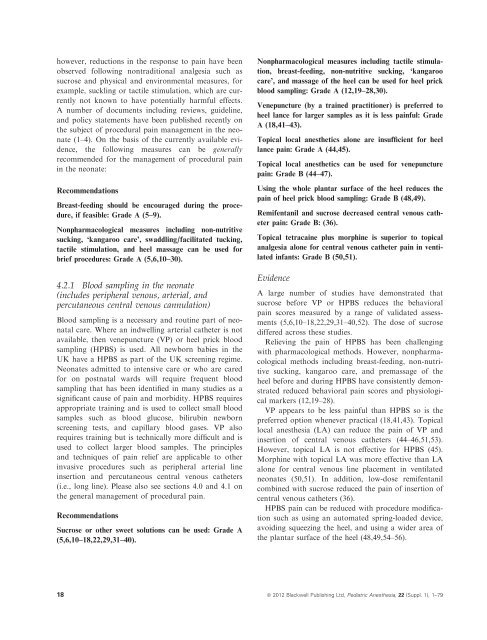Good Practice in Postoperative and Procedural Pain Management ...
Good Practice in Postoperative and Procedural Pain Management ...
Good Practice in Postoperative and Procedural Pain Management ...
You also want an ePaper? Increase the reach of your titles
YUMPU automatically turns print PDFs into web optimized ePapers that Google loves.
however, reductions <strong>in</strong> the response to pa<strong>in</strong> have beenobserved follow<strong>in</strong>g nontraditional analgesia such assucrose <strong>and</strong> physical <strong>and</strong> environmental measures, forexample, suckl<strong>in</strong>g or tactile stimulation, which are currentlynot known to have potentially harmful effects.A number of documents <strong>in</strong>clud<strong>in</strong>g reviews, guidel<strong>in</strong>e,<strong>and</strong> policy statements have been published recently onthe subject of procedural pa<strong>in</strong> management <strong>in</strong> the neonate(1–4). On the basis of the currently available evidence,the follow<strong>in</strong>g measures can be generallyrecommended for the management of procedural pa<strong>in</strong><strong>in</strong> the neonate:RecommendationsBreast-feed<strong>in</strong>g should be encouraged dur<strong>in</strong>g the procedure,if feasible: Grade A (5–9).Nonpharmacological measures <strong>in</strong>clud<strong>in</strong>g non-nutritivesuck<strong>in</strong>g, ‘kangaroo care’, swaddl<strong>in</strong>g/facilitated tuck<strong>in</strong>g,tactile stimulation, <strong>and</strong> heel massage can be used forbrief procedures: Grade A (5,6,10–30).4.2.1 Blood sampl<strong>in</strong>g <strong>in</strong> the neonate(<strong>in</strong>cludes peripheral venous, arterial, <strong>and</strong>percutaneous central venous cannulation)Blood sampl<strong>in</strong>g is a necessary <strong>and</strong> rout<strong>in</strong>e part of neonatalcare. Where an <strong>in</strong>dwell<strong>in</strong>g arterial catheter is notavailable, then venepuncture (VP) or heel prick bloodsampl<strong>in</strong>g (HPBS) is used. All newborn babies <strong>in</strong> theUK have a HPBS as part of the UK screen<strong>in</strong>g regime.Neonates admitted to <strong>in</strong>tensive care or who are caredfor on postnatal wards will require frequent bloodsampl<strong>in</strong>g that has been identified <strong>in</strong> many studies as asignificant cause of pa<strong>in</strong> <strong>and</strong> morbidity. HPBS requiresappropriate tra<strong>in</strong><strong>in</strong>g <strong>and</strong> is used to collect small bloodsamples such as blood glucose, bilirub<strong>in</strong> newbornscreen<strong>in</strong>g tests, <strong>and</strong> capillary blood gases. VP alsorequires tra<strong>in</strong><strong>in</strong>g but is technically more difficult <strong>and</strong> isused to collect larger blood samples. The pr<strong>in</strong>ciples<strong>and</strong> techniques of pa<strong>in</strong> relief are applicable to other<strong>in</strong>vasive procedures such as peripheral arterial l<strong>in</strong>e<strong>in</strong>sertion <strong>and</strong> percutaneous central venous catheters(i.e., long l<strong>in</strong>e). Please also see sections 4.0 <strong>and</strong> 4.1 onthe general management of procedural pa<strong>in</strong>.RecommendationsSucrose or other sweet solutions can be used: Grade A(5,6,10–18,22,29,31–40).Nonpharmacological measures <strong>in</strong>clud<strong>in</strong>g tactile stimulation,breast-feed<strong>in</strong>g, non-nutritive suck<strong>in</strong>g, ‘kangaroocare’, <strong>and</strong> massage of the heel can be used for heel prickblood sampl<strong>in</strong>g: Grade A (12,19–28,30).Venepuncture (by a tra<strong>in</strong>ed practitioner) is preferred toheel lance for larger samples as it is less pa<strong>in</strong>ful: GradeA (18,41–43).Topical local anesthetics alone are <strong>in</strong>sufficient for heellance pa<strong>in</strong>: Grade A (44,45).Topical local anesthetics can be used for venepuncturepa<strong>in</strong>: Grade B (44–47).Us<strong>in</strong>g the whole plantar surface of the heel reduces thepa<strong>in</strong> of heel prick blood sampl<strong>in</strong>g: Grade B (48,49).Remifentanil <strong>and</strong> sucrose decreased central venous catheterpa<strong>in</strong>: Grade B: (36).Topical tetraca<strong>in</strong>e plus morph<strong>in</strong>e is superior to topicalanalgesia alone for central venous catheter pa<strong>in</strong> <strong>in</strong> ventilated<strong>in</strong>fants: Grade B (50,51).EvidenceA large number of studies have demonstrated thatsucrose before VP or HPBS reduces the behavioralpa<strong>in</strong> scores measured by a range of validated assessments(5,6,10–18,22,29,31–40,52). The dose of sucrosediffered across these studies.Reliev<strong>in</strong>g the pa<strong>in</strong> of HPBS has been challeng<strong>in</strong>gwith pharmacological methods. However, nonpharmacologicalmethods <strong>in</strong>clud<strong>in</strong>g breast-feed<strong>in</strong>g, non-nutritivesuck<strong>in</strong>g, kangaroo care, <strong>and</strong> premassage of theheel before <strong>and</strong> dur<strong>in</strong>g HPBS have consistently demonstratedreduced behavioral pa<strong>in</strong> scores <strong>and</strong> physiologicalmarkers (12,19–28).VP appears to be less pa<strong>in</strong>ful than HPBS so is thepreferred option whenever practical (18,41,43). Topicallocal anesthesia (LA) can reduce the pa<strong>in</strong> of VP <strong>and</strong><strong>in</strong>sertion of central venous catheters (44–46,51,53).However, topical LA is not effective for HPBS (45).Morph<strong>in</strong>e with topical LA was more effective than LAalone for central venous l<strong>in</strong>e placement <strong>in</strong> ventilatedneonates (50,51). In addition, low-dose remifentanilcomb<strong>in</strong>ed with sucrose reduced the pa<strong>in</strong> of <strong>in</strong>sertion ofcentral venous catheters (36).HPBS pa<strong>in</strong> can be reduced with procedure modificationsuch as us<strong>in</strong>g an automated spr<strong>in</strong>g-loaded device,avoid<strong>in</strong>g squeez<strong>in</strong>g the heel, <strong>and</strong> us<strong>in</strong>g a wider area ofthe plantar surface of the heel (48,49,54–56).18 ª 2012 Blackwell Publish<strong>in</strong>g Ltd, Pediatric Anesthesia, 22 (Suppl. 1), 1–79
















